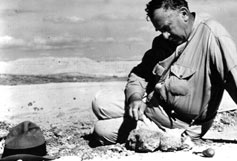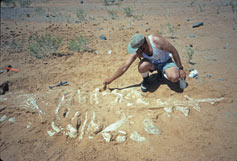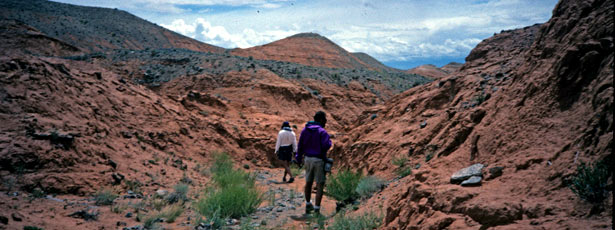Collecting
Fieldwork, involving targeting potential fossiil-bearing rocks, then prospecting for, excavating, and collecting fossils, is what most people think of when they hear the word paleontology. Popular culture references to expeditionary work and paleontological excavation make it seem exciting and glamorous. It certainly can be thrilling to discover a fossil that has been buried for millions of years, but even if you manage to find a fossil (and they are very rare) excavation is painstaking and physically demanding work.
Early Fieldwork
“In the early days of paleontological fieldwork, fossils were picked and pried out of the rock in which they had so long been encased, and the remains, usually in hundreds of small fragments were scooped up into bags to be carted back to the laboratory for tedious assembly” (Colbert, 1980, p. 63).

In the mid-19th century, collectors in the American West would normally gather fossil fragments that were visible on the ground’s surface. The collector would dismount from his horse, look for additional pieces, place them in his saddlebag, and ship them back East with minimal packaging. When they arrived, hundreds of small fragments with little or no accompanying information would have to be laboriously pieced together.
By the early 20th century field techniques had improved. John Bell Hatcher was one of the first paleontologists to develop a systematic collecting process, which recorded the type, position, and orientation of fossils in the field. With the expansion of railroads in the American West, collectors were no longer as reliant on pack animals or wagons for transporting specimens. For more information on early collecting and preparation techniques visit this site’s History page.
The emphasis on field records has steadily increased in importance since Hatcher’s time. For paleontologists, fossil collection often is as much about collecting data as it is about collecting specimens, so the information associated with the specimen can be as significant as the actual fossil.
 These data also are vital to the work of the preparator; they can provide information that helps to locate parts of the fossil that are buried deep in the rock and help to reassemble fragmentary specimens. Whenever feasible, involving a trained preparator in the excavation process helps ensure that the steps carried out in the field, such as jacketing the specimen, are done in a way that will assist the work back in the lab.
These data also are vital to the work of the preparator; they can provide information that helps to locate parts of the fossil that are buried deep in the rock and help to reassemble fragmentary specimens. Whenever feasible, involving a trained preparator in the excavation process helps ensure that the steps carried out in the field, such as jacketing the specimen, are done in a way that will assist the work back in the lab.
Resources
For more on how fossils are collected and brought back to the lab read on:
- Read a non-technical overview on collecting in Preserving Vertebrate Fossils: Notes from the Laboratory by Gregory Brown, Chief Preparator, Division of Vertebrate Paleontology, University of Nebraska State Museum.
- For more general information on excavating fossil specimens and how museums acquire specimens visit the Paleontology Portal Collection Management Module.
- Read an essay The Past Recaptured, Again by American Museum of Natural History Senior Scientific Assistant Carl Mehling on specimens collected and awaiting preparation.
- For technical information consult Patrick Leiggi, Charles R. Schaff, and Peter May. 1994. Field Organization and Specimen collecting. Vertebrate paleontological techniques Volume 1. Patrick Leiggi and Peter May eds. New York: Cambridge University Press.
- Read more about the history of collecting by downloading Peter Whybrow’s 1985 article “History of Fossil Collecting and Preparation Techniques”
- Read an excerpt from a 1906 letter from William Diller Matthew, which gives an interesting taste of his experience collecting fossils in Porcupine Creek.
- Charles H. Sternberg wrote A Story of the Past or The Romance of Science, published by Sherman, French and Company, Boston, 1911. Read a poem excerpted from In the Laramie describing discovery, excavation, and transport of AMNH FARB 5060 Edmontosaurus sp.


